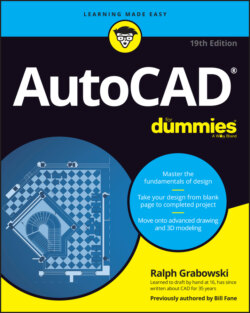Читать книгу AutoCAD For Dummies - Ralph Grabowski - Страница 35
Crossing your hatches
ОглавлениеThe next editing task is to add crosshatching to the space between the inner and outer edges of the column. The hatch lines indicate that the drawing shows a cross section of the column. To do so, follow these steps:
1 Turn off Object Snap (F3), Ortho (F8), and Snap (F9) modes by clicking their respective buttons on the status bar or by pressing the indicated function key until the icons look dimmed.
2 Select the Hatch layer from the Layer drop-down list at the top of the Layers panel on the Home tab.
3 On the Home tab’s Draw panel, click the Hatch button (shown in the margin) or type Hatch at the keyboard.The Hatch Creation tab appears on the Ribbon. For more information on this tab, and on hatching in general, see Chapter 15. Note that the Ribbon now has a light blue line around it and all the panels now show actions related to creating and formatting crosshatching.
4 On the Hatch Creation tab’s Pattern panel, select ANSI31.Depending on your screen resolution, the panels may show more or less information. If you don’t see an ANSI31 sample swatch, click the down arrow at the bottom of the lower-right corner of the Pattern panel. A scrollable list of all available patterns will appear. The ANSI31 swatch is the American National Standards Institute (ANSI) standard pattern number 31 (ANSI 31) and not ANS 131. Move the cursor over the drawing objects.A live preview shows you the result if you click at the current crosshair position. AutoCAD prompts you:Pick internal point or [Select objects/Undo/seTtings]: Move the cursor so it's between the inside and outside edges of the column. Zoom in if you need to get closer.The live preview shows the ANSI31 hatch pattern filling the space between the two filleted rectangles. Live preview not only shows you the pattern but also lets you preview the hatch angle and scale. In this case, it looks like the hatch pattern may be too fine.In the Scale window in the lower-right corner of the Hatch Creation tab’s Properties panel, change the value to 5 and press Tab to confirm it.Move the cursor back to the area between the two filleted rectangles to preview the hatch again. If it looks okay, click in the hatched area to confirm the hatch object, and then press Enter to finish the command.The finished column and base plate should look much like the one shown in Figure 3-7.
Perfect! But suppose that the nutty engineer (hey, I resemble that remark!) has decided that the column needs to measure 18 x 18 inches rather than 12 x 18 inches. Therefore, the base plate is too small, and the anchor bolts are in the wrong place. If you were drafting from paper on the drawing board, you’d pull out the eraser right about now to rub out half your effort — and if you were lucky, you’d have an electric eraser. At some point, you simply tore up the paper and started over, or labeled the appropriate dimensions as NTS (Not To Scale). It’s AutoCAD to the rescue.
FIGURE 3-7: Button-downed base plate.
